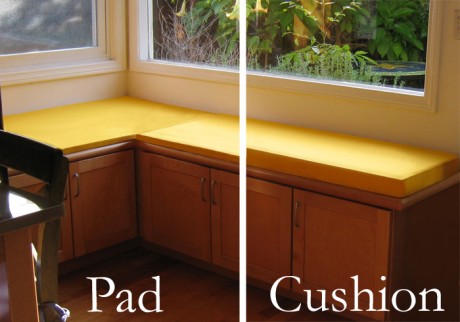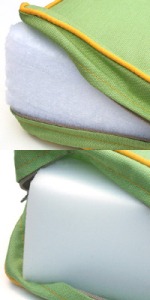There is a lot of ambiguity when it comes to finding the perfect replacement for your chair, chaise, or rocker. What is the difference between a pad and a cushion? What would meet my needs most? What is more comfortable?
The difference between a chair pad and cushion is often times based on thickness. A pad is typically 1” to 2” thick, many companies won’t make them any thinner than 2” because the weight of one’s body sitting on the pad will hurt its ability to bounce back. Cushions, on the other hand, tend to run between 3-8” in thickness, allowing for a softer seat and a greater ability to bounce back, because your weight will be distributed across the cushion’s material.
The better choice for you is dependent upon your application. Here are some things to consider:
- Will this pad or cushion be used inside or outside?
- Does the chair or bench have arms?
- Does it have a way to secure a cushion on with ties?
- Do you want tufting?
- If there is a pre-existing cushion, about how thick is it? (Note: This is not the best method for getting an exact thickness, as older cushions have typically been compacted over time and use.)
- What is your budget for creating custom pads or cushions?
- How much will this pad or cushion be used?
If you will be using your pad or cushion outside, you may want to consider drainage issues in case you plan to leave your cushions outside constantly. The summer is known for sporadic showers that can leave your cushions soaked, and while our material is graded for indoor and outdoor use, it may take longer for a thick, deep seating cushion to dry thoroughly than one that is thinner.
An extra thick cushion may be the first thing you think you want. The thought of an 8” cushion packed with foam and wrapped in cotton batting sounds like a dream; however, having cushions that are super thick can have pitfalls. For example, if your furniture doesn’t have arms that are high enough to accommodate a cushion that thick, it can make your fabric pucker or create an awkward look and potentially an uncomfortable seat. Additionally thicker cushions can be harder to secure to your seat (even with ties). The last thing you want is to slide with your cushion when you go to sit on it. If ties are not an option, whether because of the furniture’s shape or the look that you desire, you may want to consider something thinner, such as a 2” pad, so that you will have more control over where the cushion goes as you sit.
Tufting is a technique used on many cushions for an upholstered look. It’s especially popular on wicker furniture, and can be a good option if you’re not 100 percent sure of your measurements as it has the ability to give or take a little without losing its look.
If your piece of furniture already has a cushion on it, this can help guide you to whether a seat pad or cushion is the better option. Our thickness is determined between the seams. What this means for you: looking at your old cushion, measure the width between the top seam and bottom seam (hint: try using the side that faces the back of your furniture, as it typically doesn’t get as pulled or rolled under as the front side doe, due to how a body sits and rises, not to mention the weight of your legs hanging over.) This can also help if you’re not sure how high your body will sit on the new cushion; the last thing you want is for your feet to not be able to touch the floor.
 If you are on a budget, then a pad may be your better option, as they are typically more economical. If you are set on purchasing a cushion, depending upon the length and width of the area you are covering, you can create more flexibility in your budget simply by having a little give on how thick you really want your cushion to be. For example, going from a 5” cushion down to 4” can help keep you on budget both with the actual cushion cost and shipping rates, while not forcing you to sacrifice comfort!
If you are on a budget, then a pad may be your better option, as they are typically more economical. If you are set on purchasing a cushion, depending upon the length and width of the area you are covering, you can create more flexibility in your budget simply by having a little give on how thick you really want your cushion to be. For example, going from a 5” cushion down to 4” can help keep you on budget both with the actual cushion cost and shipping rates, while not forcing you to sacrifice comfort!
The last, and possibly one of the most important things to consider, is the amount of traffic your furniture will have. If this is a chair, sofa, or bench that is (or will be) constantly utilized by your family members and their various sizes, you may want to consider a cushion made of foam in thickness of 4” or more. Foam has much better shape retention than Cumuplush and will perform better in high-traffic conditions. If this is a piece of furniture that is likely to be for more decorative purposes or for more occasional use, such as a formal dining room area, then a 2” of thick foam or Cumuplush pad may be a better and more economical option for you to choose.
There is truly no right or wrong answer when it comes to choosing between a custom cushion and a custom pad. It is simply a matter of what will meet your needs most. Fortunately, we have a friendly staff of cushion experts who are happy to help answer any questions you may have and help you determine what may meet the needs of your particular application.
You can look all of our pad and cushion options by clicking here.